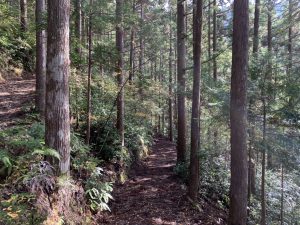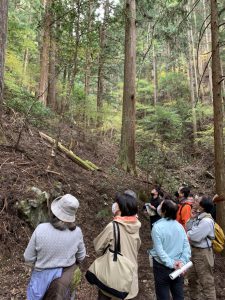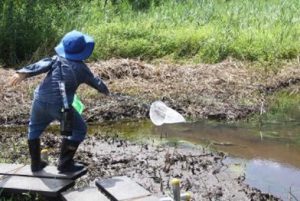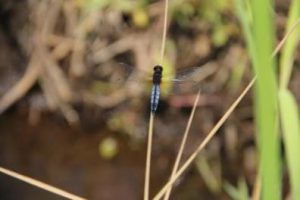[四国EPO・四国ESDセンターが、みなさんにおすすめしたい!と思った事例をご紹介していきます]
持続可能な森林経営が多面的な生態系サービスを創出 橋本林業 / Sustainable Forest Management Creates Multifaceted Ecological Services – Hashimoto Ringyo / 可持续的森林经营创造出了多方面的生态服务 桥本林业
橋本林業は、徳島県の那賀川中~上流域において明治40年ころから植林を始め、4代続く専業の自伐林家であり、現在は家族3人が施業・経営を行っています。
本年度、環境省による「30by30目標」の達成に向けた「OECM」の設定・管理を試行する自然共生サイト(前期)に参加、審査委員会から認定に相当すると評価されており、生物多様性保全の観点からも注目を集めています。
※「30by30目標」
劣化・損失を続ける生物多様性を2030年までに快復の軌道に乗せるために設定が検討されている国際目標で、「2030年までに陸域と海域それぞれの30%を保護地域にする」というもの。
※OECM(Other Effective area-based Conservation Measures)
「その他の効果的な地域をベースとする手段」と訳され、自然公園・鳥獣保護・保護林などの既存の保護地域ではないが、効果的な生物多様性保全が行われている場所、すなわち「人と自然との共生地域」を指します。
本年11月、山林を歩きながら具体的な施業についてご説明いただく機会を得ました。
橋本林業では、所有する約113haの山林を10等分し、毎年10ha程度に間伐を行うことによって複層林を創出し、平均樹齢は80年程度とのこと。真っ直ぐに育った立派なスギに並び、シイの高木も多く見られ、一般的な人工林の風景とは大きく印象が異なります。「台風や風、雨対策として、尾根には常緑樹を残しています。自然をしっかり観察して施業するように心がけています」。スギ林の低層にクロモジも多く生育し、見上げると樹冠から光が入り込み、気持ちのよい森となっています。

■高密度に作業道が敷設され、間伐が行き届き、多様な樹齢の人工林に整備されています

■解説を受け、防災にも貢献する施業について理解を深めました
天然工林として、尾根筋と谷筋を中心に、モミ、ケヤキ、シイ、カシなどが生育する針広混交林が形成されており、250種以上の植物が存在、徳島県版レッドリストに掲載されている植物10種が確認されているそうです。そして、広葉樹の落ち葉は腐葉土となって栄養豊富で保水力の高い土壌をつくり、健康な木を育みます。低木・下草が維持されていることも貢献して保水力が高まり、他の林地と比べて洪水ビーク流量を低下させていることが、専門家らの測量結果から確認されています。
さらにこの山林の大きな特徴は、幅員2.3m前後、切取法高は原則1.4m以内で、高密度に作業道を敷設していること。伐倒した木を2トントラックおよび3トンのフォワーダーで効率よく搬出でき、斜面の強度維持のために負荷が少なく、水の流れに配慮した道づくりが行われています。
「林業においても、時代の流れやはやりがあり、以前は委託して施業を行ってきたことがありますが、今は家族で変わらないものと改善するものを見極めてやっています」。自然と向き合い、長期的な視点を持って日々の施業を行う林業において、経営理念・経営方針を家族で実践されていることが、持続可能な森林経営を実現していると感じました。
森林を歩きながら具体的な施業について解説していただき、間伐の行き届いた多様な樹齢の人工林が維持され、崩壊を起こさず、保水力が高く、生物多様性保全に寄与している美しい森林を創出することができる林業について理解を深めるとともに、OECMの在り方についてもイメージを広げる機会となりました。
Sustainable Forest Management Creates Multifaceted Ecological Services – Hashimoto Ringyo
Hashimoto Ringyo began planting trees along the middle to upper reaches of the Nakagawa River in Tokushima in 1907. The Hashimoto family have been full-time independent foresters for four generations, and the company is currently run and managed by three family members.
This fiscal year, they participated in the first phase of a pilot program by the Ministry of the Environment to designate natural coexistence sites that establish and manage “OECMs” to meet the goals of the 30 by 30 initiative. They received a passing evaluation from the panel of judges, attracting attention from the standpoint of preserving biodiversity.
※30 by 30 Initiative
30 by 30 is a worldwide initiative to put biodiversity, which has been in decline, on the path to recovery by 2030. Its goal is to designate 30% of the earth’s land and ocean areas as protected areas by 2030.
※OECM (Other Effective area-based Conservation Measures)
Other effective area-based conservation measures or “OECMs” are sites outside of natural parks, bird sanctuaries, forest preserves and other protected areas, that are enacting effective measures to preserve biodiversity — that is, places where humans and nature coexist.
In November of this year, I had the opportunity to walk through a mountain forest and hear an explanation of their specific operations.
Hashimoto Ringyo owns about 113 ha of forest divided into 10 equal parts, and thins about 10 ha every year to create a multi-layered forest with an average tree age of around 80 years. Many tall Japanese chinquapin trees can be seen standing side by side with fine, straight-growing Japanese cedars, giving a distinctly different impression than most planted forests. “We leave evergreen trees on the ridges to protect against typhoons, wind, and rain,” my host tells me. “We try to conduct our operations by carefully observing nature.” Kuromoji grows thick in the lower layers of the cedar forest, and light filters in through the canopy above, creating a pleasant atmosphere.
■High-density work paths have been made, and it has been well-thinned and maintained as a planted forest with diverse tree ages.
■We received an explanation and deepened our understanding of operations that contribute to disaster prevention.
As a natural planted forest, a mixed coniferous forest of momi fir, Japanese zelkova, Japanese cedar and Japanese oak has formed mainly along the ridges and valleys. Over 250 species of plants have been confirmed, including 10 on the Tokushima Prefecture Red List. And, the fallen leaves from broad-leaved trees become humus, creating fertile soil with high water retention, which nurtures healthy trees. The preservation of shrubs and underbrush also contributes to increased water retention, which has been confirmed by the results of specialist’s surveys to reduce peak flow during flooding compared to other forested areas.
Moreover, one of the defining features of this mountain forest is its high density of work paths, measuring around 2.3 meters across with a cut and fill slope height within 1.4 meters as a rule. The paths are designed so that felled trees can be efficiently carried out on either a 2 ton truck or a 3 ton forwarder, with less load to maintain the integrity of the slope, and with consideration for the flow of water.
“Even in forestry, there are trends and fads. While there was a time when we outsourced our operations, now we are working as a family to determine what will remain the same and what needs to improve.” In the forestry business, where day to day operations are carried out with a long view toward their impact on nature, I felt that Hashimoto Ringyo’s management philosophy and policies, carried out as a family are a realization of sustainable forest management.
Walking through the forest while learning about Hashimoto Ringyo’s operations not only deepened my understanding of how forestry can maintain planted forests with a variety of tree ages through proper thinning, and create beautiful, biodiverse forests with excellent water retention that won’t collapse, it also provided an opportunity to expand my conception of what an OECM can be.
可持续的森林经营创造出了多方面的生态服务 桥本林业
桥本林业在明治40年前后开始在德岛县中川的中上游种植树木,四代人一直是一个全职自伐型林业的家庭,目前由3个家庭成员进行管理和经营。
本年度,我们参加了环境部为实现“30by30目标”而实施的设置“OECM和管理的自然共生网站,被审查委员会评价为等同于认证,并且在保全生物多样性的角度上也引起了关注。
※「30by30目标」
这是一个国际目标,目标设定为到2030年使持续恶化和丧失的生物多样性走上恢复的轨道,「到2030年使30%的陆地和海洋区域成为保护区」。
※OECM(其它有效的区域保护措施)
译为“其它有效的区域保护措施”,不是指自然公园、鸟兽保护、保护林等现有的保护区,而是指有效生物多样性保护的地方,即“人与自然共生的地区”。
今年11月,在森林里漫步时有机会听到了关于森林管理的具体说明。
桥本林业把所有的约113公顷的森林分成10等份,每年将其疏伐至约10公顷,使其成为平均树龄约80年的多层森林。 两旁是笔直生长的锦绣雪松,有许多高大的米槠树木,给人的印象与一般的人工林的风景大不相同。 「为了防止台风、风雨等自然灾害的影响,在山脊上保留了常绿树。我们致力于认真观察自然并进行管理」。 许多大叶钓樟生长在杉树林的下面,当你抬头时,光线从树冠进入,使其成为一个宜人的森林。
■ 铺设高密度的工作道路,疏伐周到,维护不同树龄的人工林。
■听完讲解后,加深了对能够防灾做出贡献的森林管理的理解。
作为天然林业生产示范基地,在山脊和山谷线周围形成了冷杉、榉树、大叶钓樟、樫树等生长的针宽混交林,并且有250多种植物,并确认到了德岛县红色名录中列出的10种植物。 阔叶树的落叶成为覆盖物,形成营养丰富、保水的土壤,培育健康的树木。 根据专家的调查结果,与其他林地相比,灌木和灌木丛的维护也有助于提高保水能力并降低洪水洪峰的流量。
而且这山林的显著特点在于,其作业道路宽度大约为2.3米左右,砍伐的树木高度原则上不超过1.4米,采用了高密度的作业道路的铺设方式。砍伐的木材可以通过2吨卡车和3吨集运机有效地搬运,为了维持斜坡的强度进行了减小负荷,考虑水流的流向的道路建设。
「对于林业,虽然也存在时代的潮流和意义,过去我们将森林管理外包过,但现在我们会认真鉴别哪些是需要进行改进,哪些是不需要改变的家族传承,并着手进行改善。」 在林业中,我们面对自然,从长远的角度来进行日常运营,我觉得家族在实践中的管理理念和管理政策,已经在实现了可持续发展的森林管理。
在森林中漫步时,我们得到了具体的关于林业管理的讲解。我们了解到,通过蔬伐人工林保持了多样的树龄,防止坍塌,保水能力得到提高,同时为生物多样性保护做出了贡献,创造了美丽的森林。这也为我们拓展关于OECM的想象空间提供了机会。
小さな林業の大きな可能性 / Big Possibilities From Small Forestry Businesses / 小型林业的巨大潜力
NPO法人84プロジェクトは、2020年度に環境省の地域循環共生圏プラットフォーム事業の採択を受け、2021年度で2カ年事業が終了しました。2022年3月18日には、2カ年事業をしめくくる84フォーラムが、高知県安芸市で開催されました。このフォーラムでは、小さな林業実践者からの報告提案、持続可能な日本の国土づくりを進める上で自伐型林業が果たす防災的な視点からみた役割などが紹介され、地元の関係者とともにSDGsの可能性を考える機会となりました。
自伐型林業を成り立たせる条件に、①林木の成長量を超えない間伐生産での自立、②壊れず使い続けることのできる小さな林内作業道の敷設、があります。中央構造線の南側にあたる高知県の山側の山林は、その条件を考慮するだけでなく、肥沃でミネラル分豊富な恵みを生かすために、破砕帯などの土地要因に対して、配慮ある施業が不可欠であるということを認識しました。
また、同プロジェクトは、森林施業の側面だけでなく、背を向け閉ざされてきた森をデザインや編集の力でわかりやすく伝え、コミュニケーションを快適にする取り組みも継続して進められました。当日のフォーラムの登壇者からは、動画や映像資料を使い、森林管理の仕事を一般の人にわかりやすく伝える必要性を「おかゆ化」という言葉で表現されるなど、デザインが担う役割と可能性を再確認することができました。
この2年間の取り組みで、同プロジェクトは、高知県内のさまざまな自治体や住民等に対し、自伐型林業を伝え、実践者の声を紹介しながら賛同の輪を広げる取り組みを展開してきました。84%の森林率を持つ高知県の森林を持続可能な形でどう活用すべきかの問いに対し、高知県佐川町では、地域おこし協力隊や移住者を中心とした小さな林業の実践者35人が誕生した報告もありましたが、このことは、1つの可視化された成果と言えます。
これらの取組は、2022年度に発行される環境白書にも取り上げられる予定です。また、四国内でも民間取組等と連携した自然環境保全(OECM)の普及啓発が始まることから、先進的な取り組み事例としても、期待が寄せられています。
Big Possibilities From Small Forestry Businesses
In FY 2020 the NPO “84 Project” was selected by the Ministry of the Environment for the Regional Recycling and Symbiosis Zone Platform Project, and the two year project came to an end in FY2021. On March 18, 2022, the 84 Forum was held in Aki City, Kochi, to wrap the project up. The forum featured reports and proposals from small forestry practitioners, introduced the role of independent foresters in promoting sustainable land development in Japan from the standpoint of disaster prevention, and provided an opportunity to think about the potential of SDGs together with local stakeholders.
The qualifications of an independent forester are: (1) the capability to perform thinning and production activities independently without exceeding the forest’s rate of growth (2) making small forest work roads that can be used continuously without breaking down. And, in the forests in the mountainous side of Kochi, south of the Japan Median Tectonic Line, it is also necessary to consider land factors such as fracture zones in order to draw out the fertile and mineral-rich blessings within.
The project continued to promote not only the aspect of forestry operations, but also efforts to make communication more comfortable and using the power of design and editing to provide easy-to-understand information about forests that have been closed. The speakers at the forum were able to reaffirm the role and potential of design, dubbing the use of images and video to make the work of forest management easier to understand for normal people as “porridge-ification.”
Over the past two years, the project has been working to inform various local governments, residents and others in Kochi about independent forestry, and expand the circle of support while introducing practitioners voices. Regarding the question of how to sustainably utilize the forests in Kochi, which make up 84% of the prefecture, there was a report that 35 small forestry practitioners came into being in Sakawa Town, mainly consisting of community building corps and immigrants. It can be said that this is one visible result.
These efforts will also be featured in the environmental white paper to be published in FY 2022. Also, since nature conservation (OECM) promotion and education in cooperation with the private sector will begin in Shikoku, there are high expectations for them as an example of advanced initiatives.
小型林业的巨大潜力
NPO法人 84项目,于2020年度被环境部选为地区循环共生圈纲领项目,为期2年的项目于2021年结束。 2022年3月18日,总结为期2年的84纲领项目在高知县安芸市举行。 在本次论坛上,介绍了小型林业从业者的报告案,以及自伐型林业从防灾的角度介绍了日本国家土地可持续发展的作用,成为了与当地相关者一同考虑关于SDGs的可能性的机会。
要实现自伐型林业,需要满足以下条件:①在不超过森林生长量的前提下进行采伐生产以实现自给自足;②铺设小型的林间作业道,以确保其不损坏且能够长期使用。高知县南部中央构造线以南的山林不仅需要考虑这些条件,为了利用其肥沃且富含矿物质的特点,还需要考虑如断裂带等土地因素,因此必须进行谨慎的经营。
该项目不仅涉及森林经营方面,而且通过设计和编辑的力量,将一直被忽视的森林变得易于理解和容易交流。在当天的论坛中,演讲者们使用视频和图像资料,强调了向公众传达森林管理工作的必要性,用“粥化”等词表达了设计的角色和潜力,从而再次确认了这一点。
在过去的2年中,该项目一直致力于向高知县的各个地方政府和居民传达自伐型林业,介绍从业者的声音,并扩大支持圈。 在回答森林比例为84%的高知县的森林如何可持续利用的问题时,有报道称,在高知县佐川町诞生了35名小型林业从业者,主要是社区振兴志愿者和移居者,这可以说是可视化的结果之一。
这些举措也将在2022年发布的《环境白皮书》中有待介绍。 此外,四国已经开始了与民间组织合作的自然环境保全(OECM)的普及和启蒙活动,因此人们对此作为先进事例的典范寄予厚望。
地域の力でよみがえった「王越とんぼランド」 / Ogoshi Dragonfly Land, Revived By Community Power / 被社区的力量复兴的「王越蜻蜓乐园」
香川県坂出市王越町にある「王越とんぼランド」は、坂出市の東側に位置し、三方を五色台の山々に囲まれ、北は瀬戸内海に面した自然豊かな場所にあります。
ここ「王越とんぼランド」は水田や沼地が多く、素晴らしい自然に囲まれていることから、無数のトンボが飛びかう「トンボの楽園」として地元の方々により保護されてきました。毎年「王越とんぼウォッチング」が開催されたり、近くの王越小学校では自然環境学習の一環として生徒がヤゴをトンボにかえす体験を行うなどしてきました。しかし少子化の影響により、平成23年3月に王越小学校は廃校。多くの方に足を運んでもらう機会が減少したことから、トンボの生息地が一時荒廃しかけるという危機に陥りました。
そんな中、平成29年に旧王越小学校が改修され、「宿泊型野外活動施設 交流の里おうごし」がオープン。その近くにある「王越とんぼランド」も活用すべく、平成30年に地元の住民の方々を中心とした「王越とんぼプロジェクト実行委員会」が発足し、「王越とんぼランド」の再生プロジェクトが始まりました。
トンボが群れ、飛ぶ姿を取り戻すため、地域と行政が一体となり、トンボの専門家やボランティアなど大勢の方々の協力も得て、水辺の環境を整備するとともに、観察しやすいよう遊歩道も作り、トンボの楽園がよみがえりました。令和元年には「王越とんぼランド」リニューアルオープンイベントを行い、今では、「交流の里おうごし」利用者の体験学習プログラムとして里山散策コースの中に組み込まれたり、生涯学習講座として自然観察の会場になるなど坂出市の行事で多く利用されています。その他にも、市内小学校等が課外学習として足を運んでくれるようにもなり、王越町は「トンボの里」と呼ばれていた昔の姿を取り戻しています。


世界や国内でも生息地を奪われ、絶滅や絶滅の危機に瀕する動植物も少なくありません。ここ香川でも条件の良い水辺が失われ、トンボなどの生き物を見る機会も減りつつあります。ぜひ、“とんぼランド”で飛び回るトンボを見ると共に、周囲の自然を体感し、地域の人々の気持ちを感じ取ってください。豊かな自然とたくさんの生き物のつながり(生物多様性)から受ける恵みに気づくことができます。
Ogoshi Dragonfly Land, Revived By Community Power
Ogoshi Dragonfly Land, in Ogoshicho, Sakaide, Kagawa, is a place rich in nature. Situated in eastern Sakaide, it is surrounded on three sides by the Goshikidai mountains, and facing the Seto Inland Sea to the north.
Because of its many rice fields and marshes, it had been preserved by the local community as a “dragonfly paradise” where countless dragonflies fluttered about. There was a yearly “Ogoshi Dragonfly Watching” event, and students at the nearby Ogoshi Elementary School would raise dragonfly nymphs into adults and release them back into nature as part of their environmental studies. However, due to the declining birth rate, Ogoshi Elementary school closed in March 2011. With the number of visitors dwindling, the dragonflies’ habitat was in danger of falling into ruin.
Such was the situation when, in 2017, the former Ogoshi Elementary School was renovated and reopened as “Lodging Type Outdoor Activity Facility: Koryu-no-Sato Ogoshi.” Wanting to make use of the nearby Ogoshi Dragonfly Land as well, in 2018 the Ogoshi Dragonfly Project Executive Committee was formed by members of the local community, and the Ogoshi Dragonfly Land rejuvenation project began.
In order to return the flying swarms of dragonflies, the local community and government worked hand in hand, cooperating with a large number of people including dragonfly experts and volunteers to improve the waterside environment, building a promenade at the same time to make observation easier. With that, the dragonfly paradise was revived. In 2019, the Ogoshi Dragonfly Land reopening event was held, and now it is used for many events in Sakaide, such as being included in the Satoyama walking course — part of the learning experience program for users of Koryu-no-Sato Ogoshi — and as a venue for nature observation in lifelong learning courses. In addition, elementary schools around Sakaide have begun to visit it for extracurricular activities — proof that Ogoshi has reclaimed its former glory as the “home of dragonflies.”
Due to habitat loss in Japan and all around the world, countless plants and animals are either extinct or in danger of going extinct. Even in Kagawa, suitable waterfront areas are dwindling, and the opportunities to encounter creatures like dragonflies along with them. We hope that when you see the dragonflies flying around in “Dragonfly Land” that you also experience the natural world around you and perceive the feelings of the local community. Here, you can come to understand the blessings we can receive from the connection between bountiful nature and many living things (biodiversity).
■Ogoshi Dragonfly Land
https://www.city.sakaide.lg.jp/soshiki/syougaigakusyu/ougoshitonborando.html
■“Overflowing With Nature! Visit Ogoshi Dragonfly Land!” (Ogoshi Dragonfly Land Promotional Video)
https://www.youtube.com/watch?v=nMPcw9BRMGU
被社区的力量复兴的「王越蜻蜓乐园」
位于香川县坂出市大越町的「王越蜻蜓乐园」,位于坂出市东侧,三面环抱五木台山脉,北面面向濑户内海。
由于「王越蜻蜓乐园」拥有许多稻田和沼泽,周围环绕着美妙的大自然,有无数的蜻蜓飞翔而被称为「蜻蜓乐园」并受到了当地人的保护。 每年都会举办「王越观蜻蜓」活动,在附近的王越小学,学生们体验了将水虿(蜻蜓幼虫)变成蜻蜓,这是他们学习自然环境的一部分。 但由于受出生率下降的影响,王岳小学于3月23日关闭了。 随着参观机会的减少,蜻蜓的栖息地也面临被荒废的危机。
同时,平成29年,对旧王越小学进行了翻新,并开设了“住宿型户外活动设施交流之乡王越”。 为了利用附近的「王越蜻蜓乐园」,平成30年主要由当地居民成立了「王越蜻蜓乐园执行委员会」,开始了「王越蜻蜓乐园」的振兴工程。
为了恢复蜻蜓成群飞翔的样子,当地社区和政府在蜻蜓专家和众多志愿者的配合下,改善了河岸林的环境,为了便于观察修建了一条长廊,蜻蜓天堂得以复兴。 在令和的第一年,举行了「王越蜻蜓乐园」更新开放活动,例如现在「交流之乡王越」的利用者作为体验学习,把它纳入了里山步行路线里,作为终身学习课程和自然观察的场所,经常用于坂出市的活动。 此外,全市小学也来参观课外学习,王越町重现了昔日「蜻蜓之乡」的面貌。
在世界和日本,有很多动植物被剥夺了栖息地,处于灭绝或濒临灭绝的危机。 在香川,条件良好的河岸林也消失了,看到蜻蜓和其他生物的机会也在减少。 请看蜻蜓在“蜻蜓乐园”飞来飞去,请体验周围的自然风光,感受当地人的心情。 你可以感受到从丰富的大自然和众多生物(生物多样性)的联系中所得到的恩惠。
■王越蜻蜓乐园
https://www.city.sakaide.lg.jp/soshiki/syougaigakusyu/ougoshitonborando.html
■“充满自然气息!快来看王越蜻蜓乐园”(王越蜻蜓乐园介绍视频)
https://www.youtube.com/watch?v=nMPcw9BRMGU



